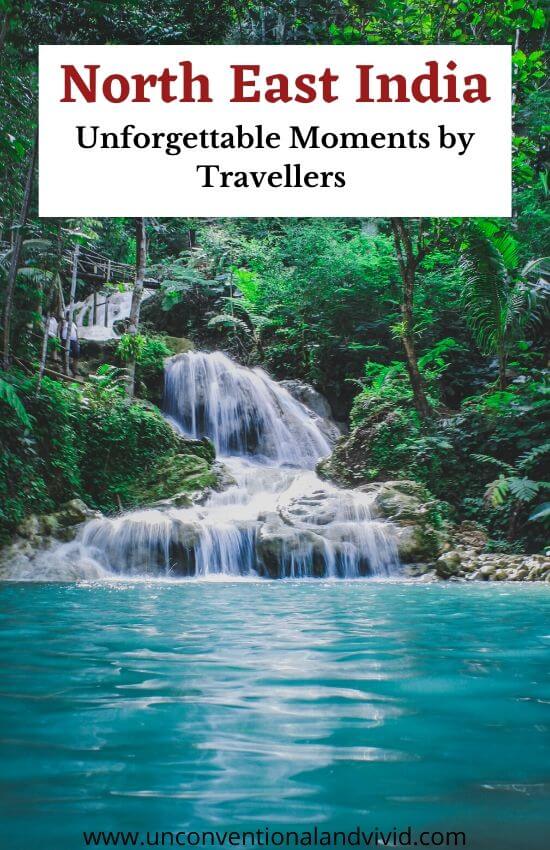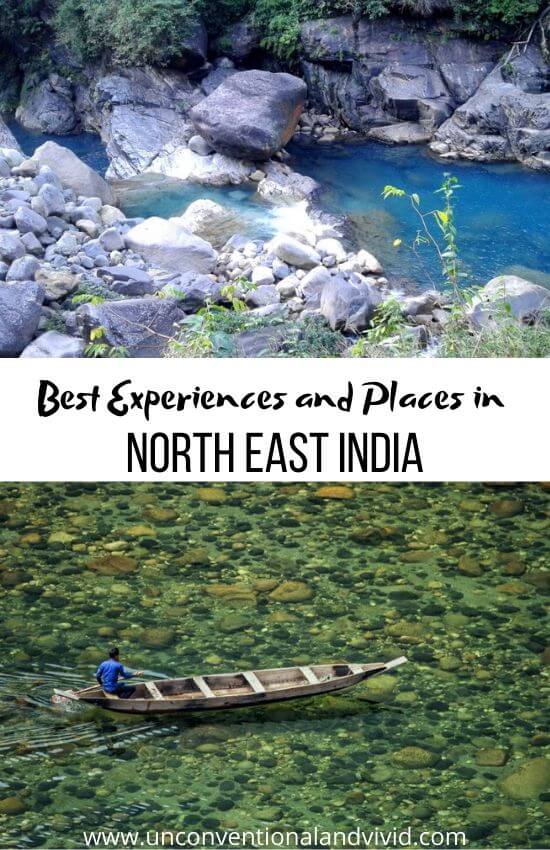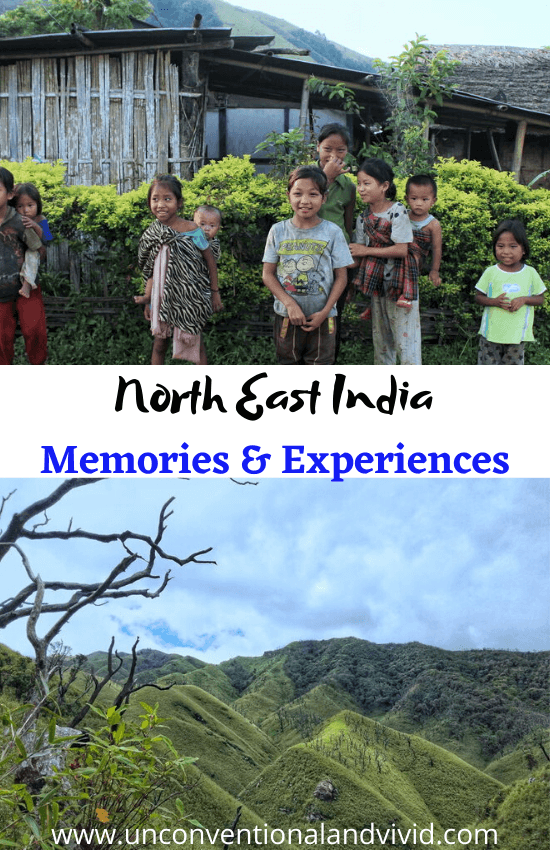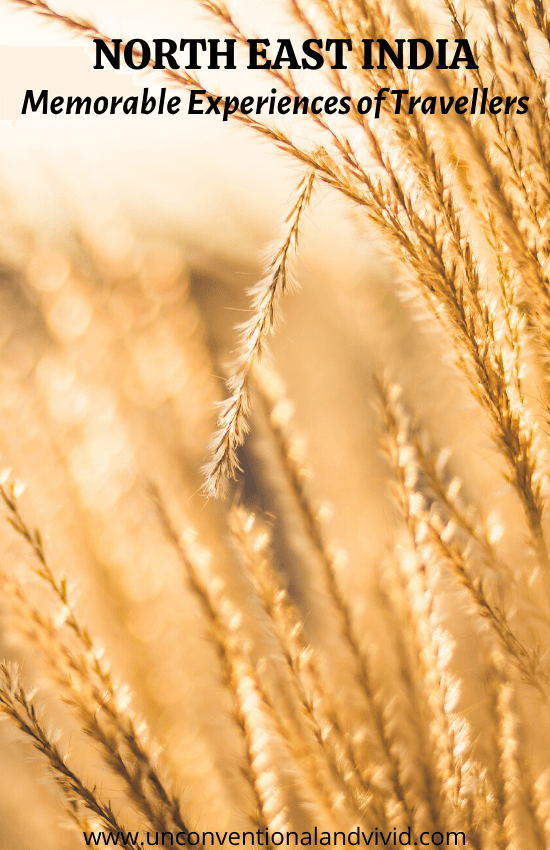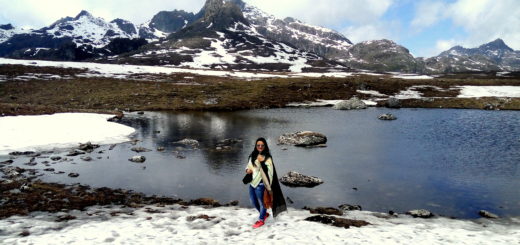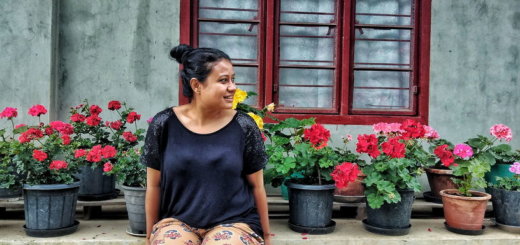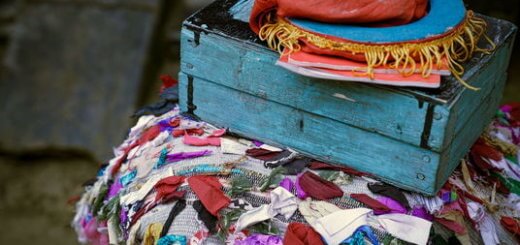North East India – Unforgettable Memories Shared by Travelers
North East India – A hotbed of tribal amalgamation, pristine landscapes, slice of warmth and together the hinterland corners stitch unforgettable memories. North East takes you through an experiential journey and blows up myths incessantly broadcasted on media. I returned from some of the most remote corners, scarcely inaccessible, with bag full of memories. If I had to pick one memory, I would be riding a roller coaster because every place opened to new experiences and conscious learning.
PIN THE POST FOR LATER
However, I asked some of my fellow bloggers and travelers, their favorite memory or moment from North-East. It is not easy to pick one, but some moments strikes the chord the hardest. See, what created that Eureka moment for my fellow travelers during their journey across North East India
Table of Contents
North East India is a Safe Net for Travelers with Friendly People
For me northeast India is unlike any other place in India. It is raw, beautiful, diverse, and contrary to what most people think – safe too. From Nagaland to Meghalaya to Arunachal Pradesh, I have traveled pretty much every place in the northeast and never did I get any hints of danger. People in the northeast are kind and helpful, just like in most other places in India.

It is a little hard choose one incident or place I love the most in Northeast as there are so many beautiful memories. But if I were to choose one, I would choose Bodoland in Assam – that I happened to visit earlier in January 2020.
Bodoland has always attracted negative air in news because of some territorial disputes that happened in the past. I remember before getting there I searched about Bodoland on Google and all I found was news about local rebellion groups fighting the government. When I got there, however, the story was rather the opposite. There were no hints of what I saw in the news. People were only busy in sorting out their lives – in growing crops, in catching fish, in laughing and enjoying with their neighbors.
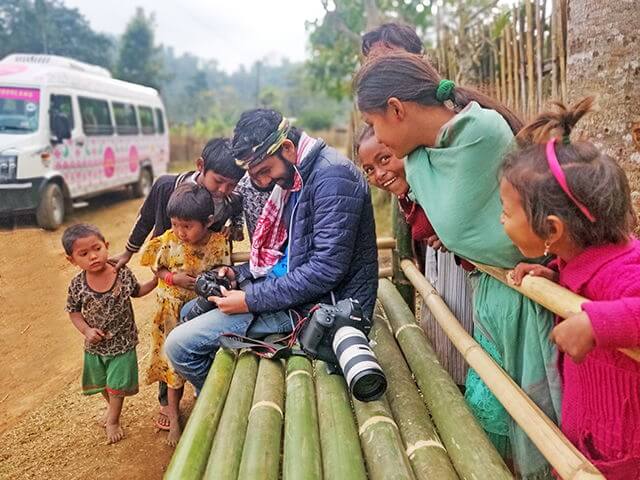
I happened to experience Dwjing Festival and a few local villages and everywhere I went, I felt just as safe as I does in Goa or someplace in Himachal Pradesh. From Arunachal to Nagaland to Meghalaya, people in northeast have always surprised me with their friendliness. And Bodoland was no different either.
Read Devesh Joshi’s Blog – www.footloosedev.com
Understanding the plight of domesticated elephants in North east India
My first encounter with domesticated elephants as an ally of everyday life was at the Kaziranga, the world UNESCO site and a frontier in rhino conservation in the whole of Indian subcontinent.
Kaziranga has gone through a lot. Political turmoil of the region took a heavy toll in her wildlife populace. A number of one horned rhino roamed in the foothills of Himalaya. The feudal kings as well as the British glorified rhino hunting. Later, trading of rhino horns at Chinese market yielded in the value of gold!
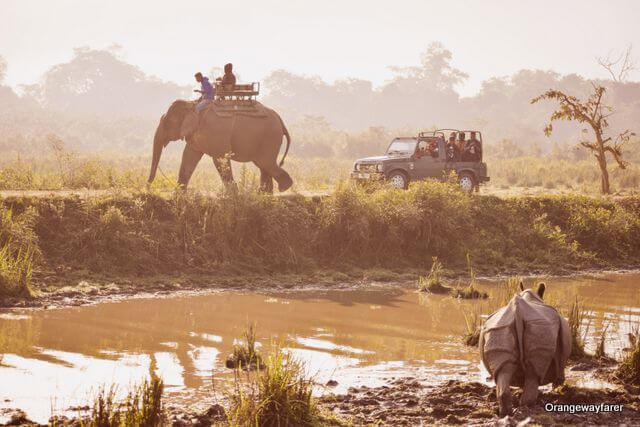
Goodwill emerged but only at the brink of the rhino population being extinct from the face of Earth. Several naturalists toiled day in and day out to restore the pride in saving rhino and raising awareness among locals. Tourism saw a boom and it brought money to the local guides who earned a livelihood previously from the role of poachers. This is a success story so far and rhinos are now happily thriving at Pobitora, Manas and Nameri national park, out of Kaziranga. However, it comes with a clause.
Men pluck remedy from nature itself. A number of domesticated elephants are used to patrolling the forests. The work for a couple of hours early in the morning and at the advent of night. They tread beyond the cemented road and the areas allowed for tourists. Kaziranga has a huge landmass hidden away from the tourists’ eyesight for all the right reasons. These elephants play a pivotal role in rescuing animals especially when the river Brahmaputra floods, every monsoon.
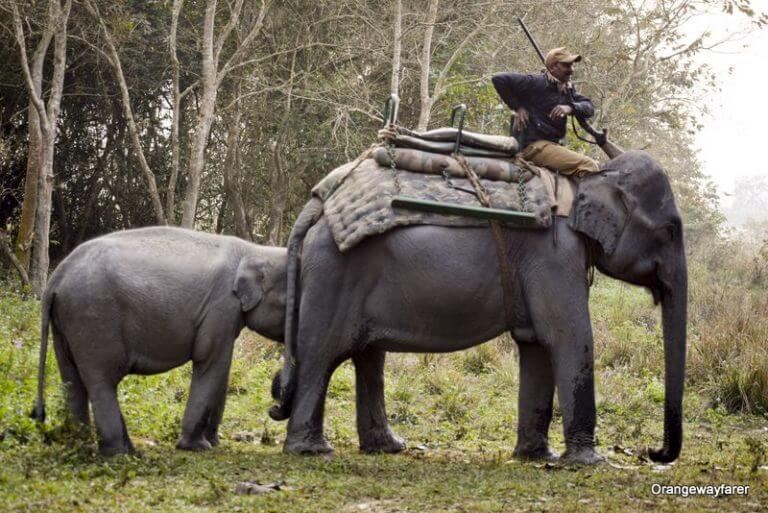
As much as it sounds relaxing, I also find discomfort thinking about the elephants in a confined state. They are mostly female, Kunki Hati, domesticated elephants. They are scared to go close to the wild free elephants. Only during mating season, they are let out in the jungle. They come back to human habitat post mating, breed, and the baby elephant inevitably get sucked into the system of slavery yet again.
“Do they get broken?”
“Yes, sometimes!”
My heart breaks looking at the one-year old baby elephant who is playing with the straw. the mother stands at a distance, with a shackle around her leg.
Sensing my gloom, the forest guard tries to help, “We can keep the rhinos because they are here!” I know. I think in my mind. Domestic elephants had been employed in myriad disdainful ways in the previous century in the roadless mountain regions of North east India. Their slave works were often unaccounted for. From log work to patrolling the forest is a sure development. But is that it? Can we not do better? I have been asking this question for long but in vain.
Read Madhurima’s Blog – www.orangewayfarer.com
Finding Happy Place in the Remote Village of Longwa, Nagaland

Someone asked me recently what your happy place is. And I have to admit that Longwa in Nagaland is my happy place in India. Longwa is right at the Burma border. In fact the King’s house is half in Burma and half in India. We stayed at a cozy homestay here run by a childless couple who have adopted two dogs as their babies – Jack and Jimmy. We would all crowd around the kitchen because in a Naga house that is where all the action is – around a fire. With layers of meat hung above it to smoke, a kettle with black tea always on.

Cats, dogs, humans- are all in that space. I have always loved the fact that food is such a ritual in the Indian culture and the Naga kitchen is the perfect embodiment of it. The whole day is planned around food and the space where food is cooked and eaten is where life is. We spent two days here just getting in the flow of things and by the second day it was almost as if I had always lived this life. It felt so organic, so real, so for me Nagaland will always be this Naga kitchen with the smell of ash, smoked meat and the warmth of Jack lying on my feet.
Read Ankita’s Blog on – www.monkeyinc.in
Community coming together to resolve problems in Nagaland
When it comes to one of the best memories of Northeast India, it is a very recent one. It was October 2019; I was on my way with my husband to Dzukou Valley in Nagaland. It had been raining incessantly since the past few days of our scheduled journey.
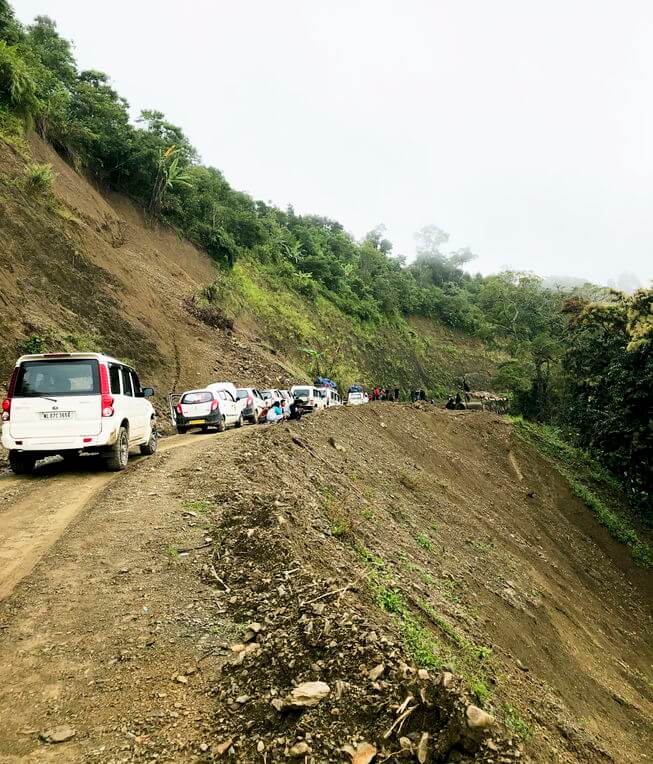
On arriving Dimapur we were informed that the highway leading to Kohima was shut down completely due to massive landslides. The only way to reach Kohima was by taking the bypass. The sumo driver had already warned us that the road was in bad condition and it would take around 7-8 hours to reach Kohima.
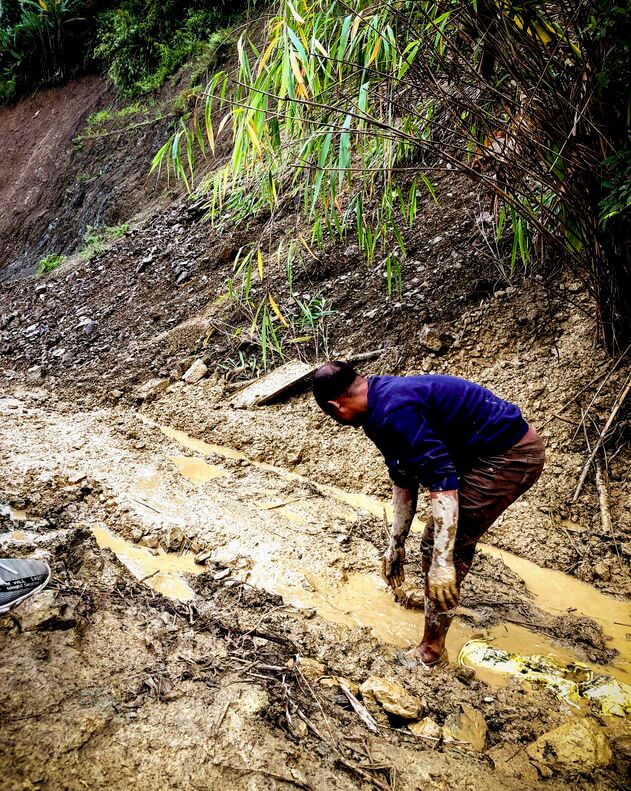
It was a bumpy ride, there was no proper road, it was all muddy and pools of water all over. We had to stop mid-way as there was a massive landslide ahead of us. But I was so overwhelmed when I reached the main spot and saw all the drivers, local villagers, and some local male passengers mending the road together. Everyone decided to make at least the cars pass through the blockade one by one. The locals were so co-operative and helpful. Had they waited for the JCB we would have stuck there whole day. There are many such instances when locals came forward for help and it makes me proud being born and brought up in Northeast.
Read Ishani’s Blog – www.buoyantlifestyles.com
Awe-inspiring Landscape of Dzukou Valley, Nagaland
The perfect summer of 2019. Four souls, hailing from Assam, Kerala and Uttar Pradesh to a paradise called Dzükou Valley. Soulful moments, cosmic tales, authentic connection, and some thrilling stories – it had it all. I mean who would not lie down and embrace the beauty of such landscapes – we did and that for 3 hours. Sitting at the top of that sole cave down the valley, we spoke little and gazed at the view for most of the time.
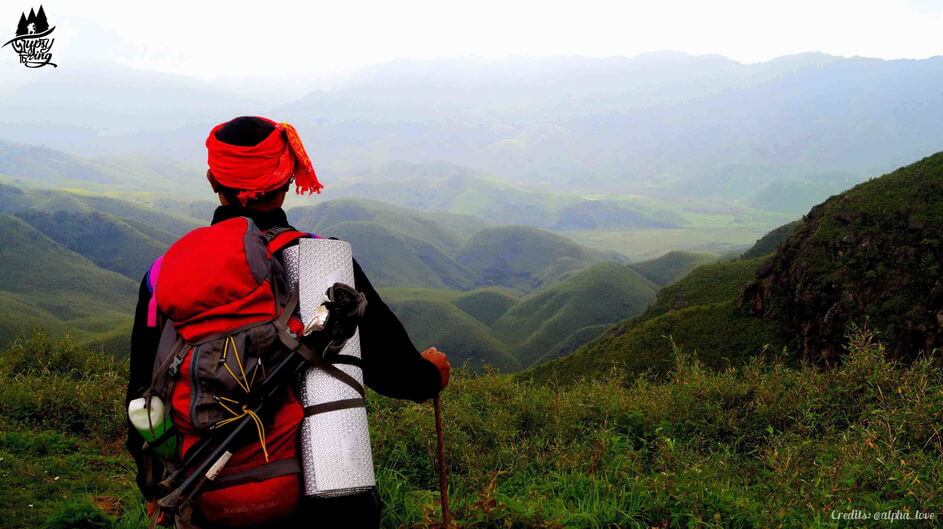
The valley surprised us with clear sky, it was overcast in the morning. Lying there and letting ourselves immerse into the energy that the valley radiated was an enriching experience.
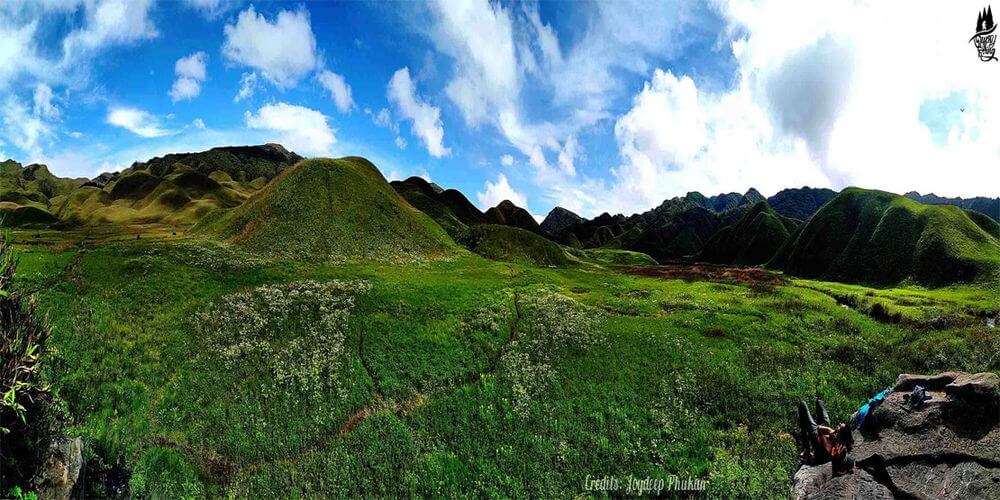
The ambiance of the valley under moonlight is heavenly. The combination of play of the clouds with the hills below, the sound of the stream and tiny little birds soothes the soul.
Read Joydeep’s blog – www.thegypsychiring.com
Attending Yazali Nyokum Yullo Festival in Hinterlands of Arunachal Pradesh
‘The best way to exist is to have a connection with nature’. With that motto, Yazali Nyokum Yullo Festival is celebrated every year in Yazali, Arunachal Pradesh. A few years back I was invited to attend this 6 day long festival where the passion for Apong and Mithun’s meat takes the center stage.
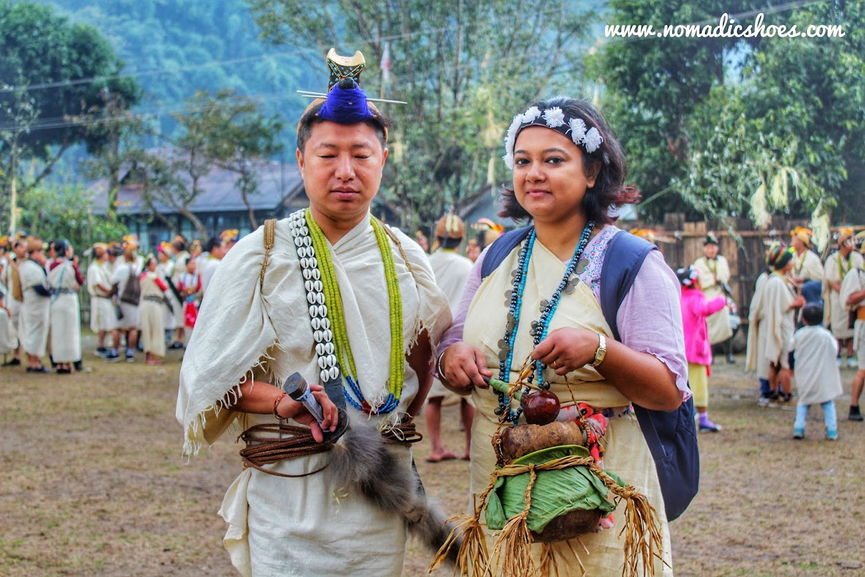
The Nyishi tribe is one of the main tribes of Arunachal Pradesh, they are the descendants of Abo Tani – a mythological ancestor like the Sun God. Nyokum Yullo is a pre-harvest celebration which takes place in February to invoke the blessings of Nyokum Goddess. The Nyishis believe that the Goddess avert natural catastrophes like droughts, earthquakes, famines and protect their fields and livestock.
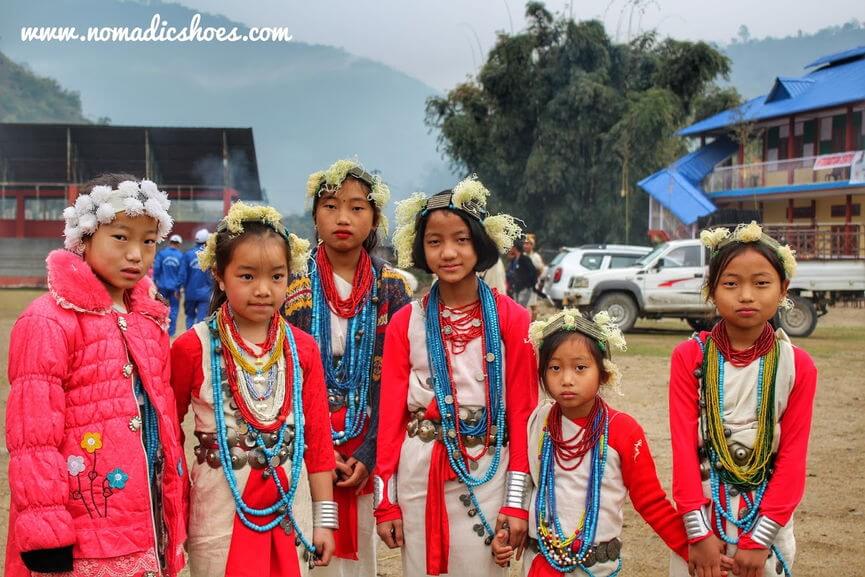
I had a great time there as a blogger and photographer. It was a feast for my eyes, seeing the riot of colours and experiencing the tribal customs of the Nyishis. I stayed in a traditional bamboo hut, drank Apong to my heart’s content and learnt about their sustainable practices. If you are curious about tribal cultures, then I suggest that you attend this festival. The people are very welcoming and make sure that you get immersed in the festivities.
Read Suman’s Blog – www.nomadicshoes.com
Experiencing Pure Nature in Shnongpedeng, Meghalaya
Without any doubt, Meghalaya is one of the gems of North-east India. The true love and devotion for nature by its local people makes it stand out. Hence, we are warmly greeted by its virgin forests, primitive cave ecosystem, beautiful waterfalls, and verdant valleys. Oh wait! There is more to this flourishing world. A hidden treasure in the Jaintia hills of Meghalaya, Shnongpedeng, did take me by surprise and bewilderment.
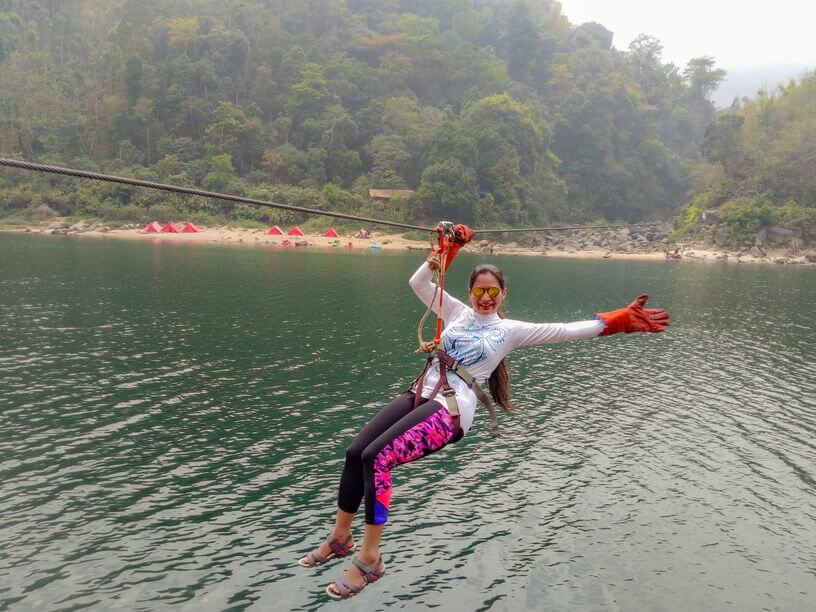
Welcoming spectacle having the illusional sight of boats floating on the water of Umngot river flowing through it and clear visibility of rock beds beneath, will remain etched in my memory.
Just 100 yards walk to the river from our cozy cottage, a full day filled with thrilling activities began. Firstly, we took 1.5 hours of boat ride in the Umngot river admiring the glistening waters, enchanting sounds of waterfall tucked away nearby, chirping sounds from surrounding dense forest, fluttering butterflies flaunting their colors, local men/women doing fishing and unmatched raw beauty. Fighting my fears of height and water, I took a plunge from a cliff, jumped into the river, swam, and stayed afloat for couple of hours to soak in the magical vibes. We did kayaking and zip lining too. Locals were so kind to let us indulge in fishing and I got lucky to catch small ones (read my grinning face).
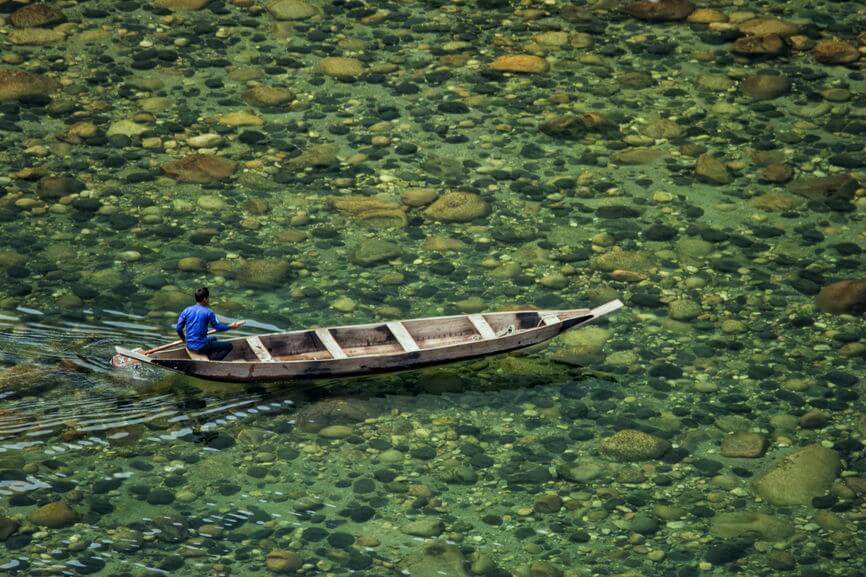
Next day, apparently, it was a declared holiday and deserted. Before leaving for the next place, I wanted to have last gaze so I walked on the suspension bridge and looked down in astonishment to find a lonely guy doing his routine fishing activity religiously (fishing being main occupation here). His self-discipline and dedication literally stole my heart. Whenever demotivation and hopelessness grips me, I look at his picture and find my sanity back.
Spotting a Baby Rhino in Pobitora National Park
In the past few months, I have had an opportunity to travel to the North-Eastern Indian states of Assam and Meghalaya. Both these travels have been wonderful, and I have had a great time. But one incident is very close to my heart and that is seeing a curious baby Rhino in the wild. Being a wildlife lover and enthusiast, I always wanted to see Rhinos in the wild. I had tried to see them thrice during my safaris previously, but those efforts had been in vain. I had never seen them and had missed them by a few minutes.
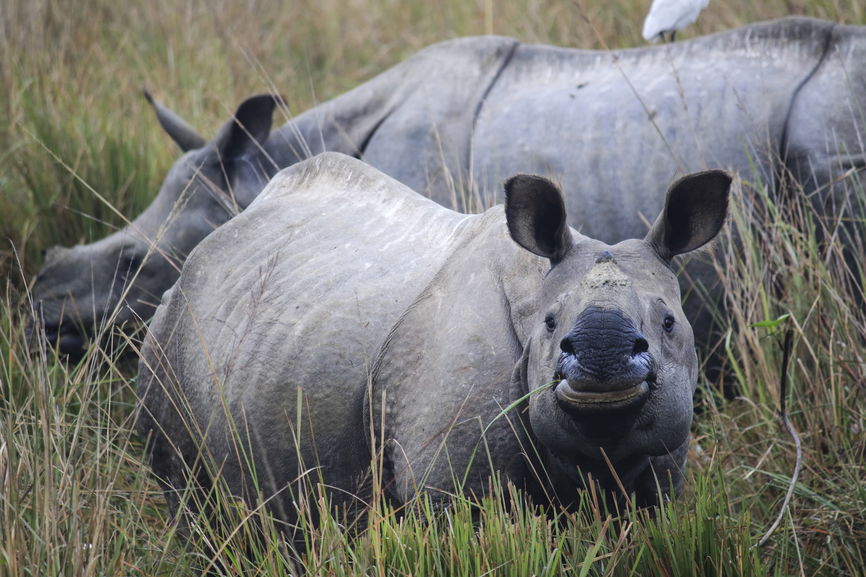
But late last year, I went on a wildlife jeep safari with my blogger friends on a FAM trip in Pobitora Wildlife Sanctuary. The sanctuary is famous for its one-horned Indian Rhinos. We did see many Rhinos there but spotting a baby Rhino was my personal best experience. The baby Rhino was grazing grass with its mother. And as our jeeps approached near, it inquisitively saw us with an innocent look while the mother ignored our jeep still grazing the grass. It was a delightful sight and an amazing one. This experience will always be my most favorite moment in the North East of India.
Read Raksha’s Blog – www.solopassport.com
A Trek to Double Decker Root Bridge in Nongriat, Meghalaya
Nongriat’s double-decker root bridge was an experience of a lifetime! Three hours of huffing and puffing down some 5000 odd steps into the mountainside—the dank tropical heat clinging to our bodies— and over rickety rope bridges exhausted us but a glimpse of the root bridge and all our fatigue disappeared.
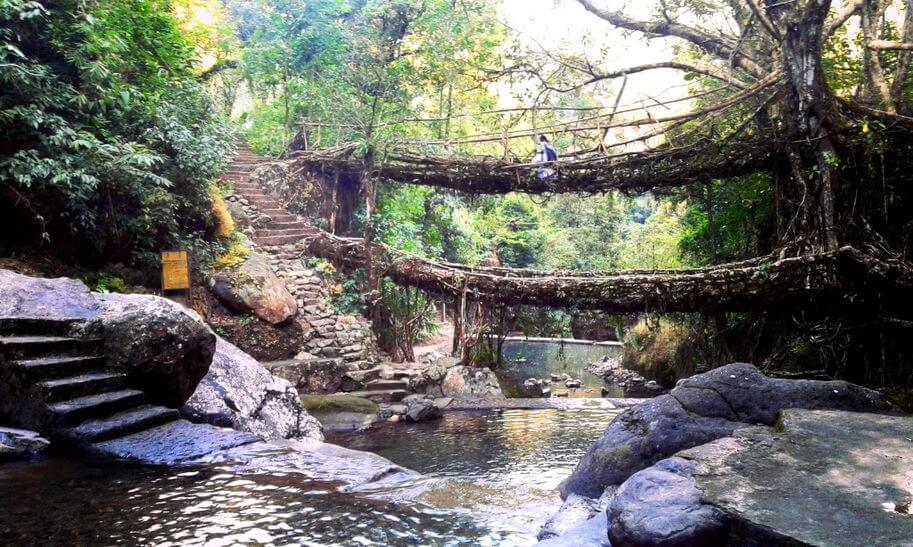
It is awe-inspiring to see how we, humans, can coexist with nature. No trees were cut, no wildlife was harmed, and yet this bridge was built successfully to improve accessibility. The hills of Meghalaya are peppered with bridges such as these, all accessible on long treks through humid jungles, that make lives a little bit easier for local tribes. In this part of the world, to reach the nearest healthcare centre, the nearest school, the nearest market, you must climb hundreds of steps, cross bridges such as these.
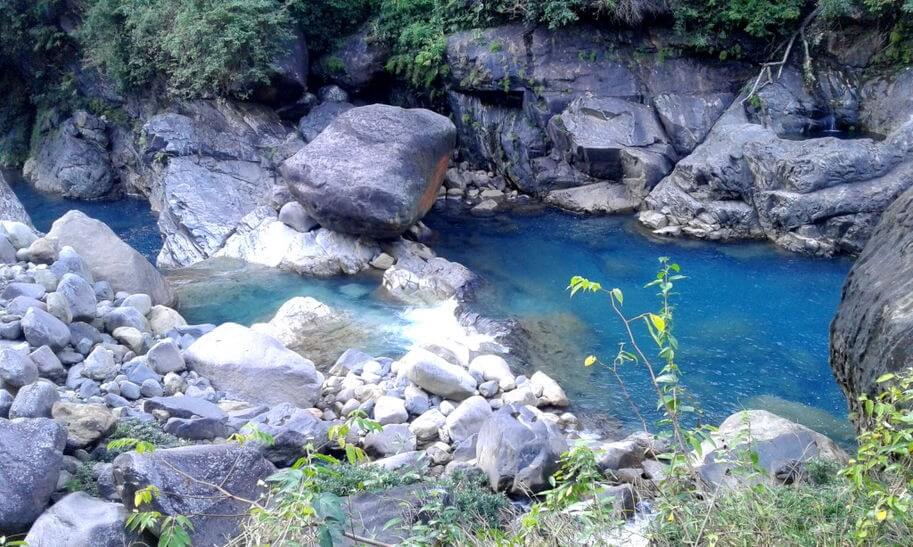
As we walk on the upper tier of the double-decker root bridge, a gush of wind whooshes down the mountainside. The bridge quivers and I clench the railing, a coiled pillar of aged rubber tree branches, and stop. Two Khasi girls in school uniform, their dark hair tied with bright red ribbons, look at me and giggle. I try to smile back while inching slowly towards solid ground. Later, we continue trekking down to our destination for the day: Rainbow Falls. Around us: pristine jungle, birdcalls, and the sound of wind waltzing through the trees, the wide palm fronds.
Read Mohana and Aninda’s Blog – www.two-together.com
Hiking through Remote Terrains of Arunachal Pradesh – A Trek to Mago
When I decided to do my month-long mountaineering course in NIMAS- Arunachal, never in my dreams thought I would explore such an unexplored beauty. As a part of the course we were supposed to move from New-Melling to Mago, (both are small villages in Tawang District) with a heavy rucksack, which had climbing equipment’s.
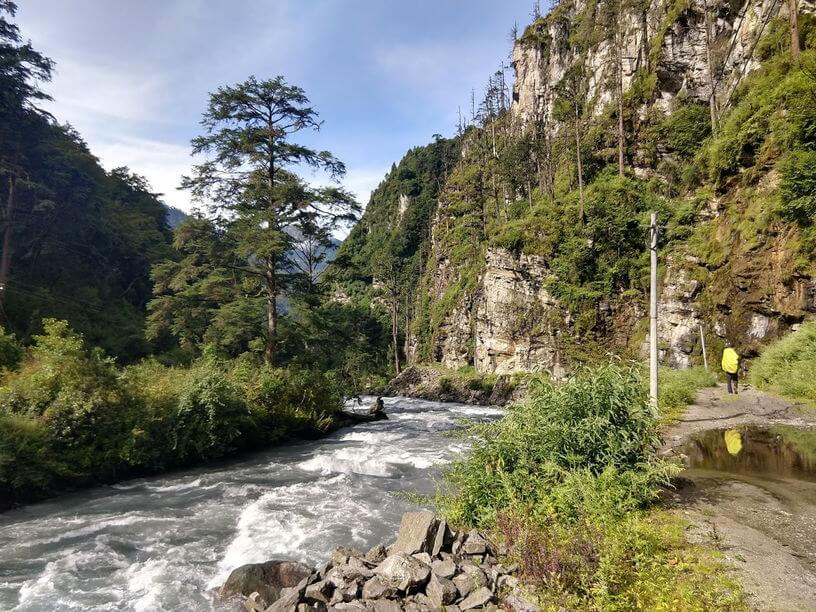
Beauty of the trek started once we crossed Hydel point. In the span on next 15 – 20 mins, we were walking in the canopy of waterfalls. For every 200-300 mts, I could see a waterfall, this stretch contained a big wall of mountain on one side and road running parallel to pristine river flowing on other side. As soon as we crossed this stretch, we entered the thick forest with river on other side. This stretch continued for a while and minutes turned into hours. The beauty of Jungle mesmerized me. After 12 hours of long walk, when we took nice bath in natural hot water springs.
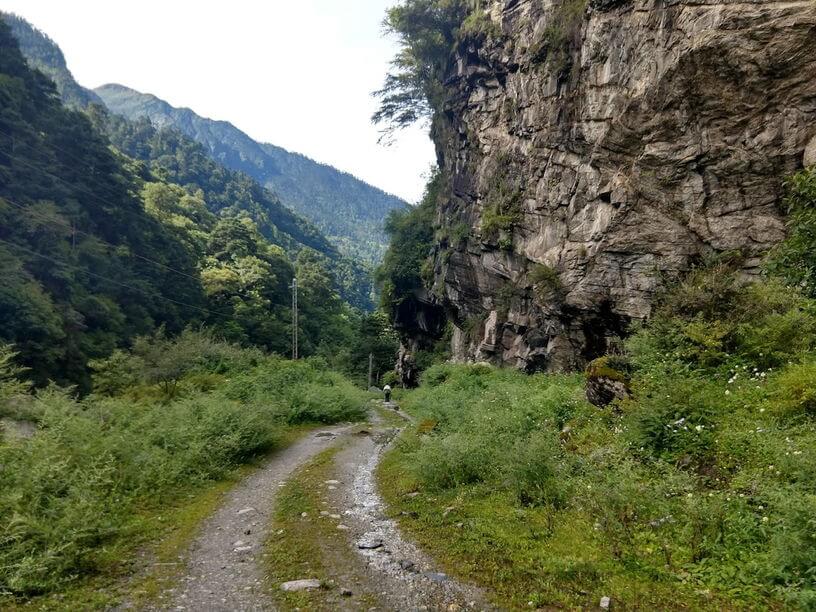
This long exhausting, tiresome walk in the beautiful forests of Arunachal, while crossing several mountains along the pristine river educated me the enormity and beauty of nature, emphasizing that cognizant development of man-kind cannot recreate which nature over years has carefully crafted it.
Read Preethi’s Blog – www.meander23.com
An Unforgettable Hospitality in Sago Village, Arunachal Pradesh
I still remember how worried I was when the organizers decided to move us from a comfortable guest house to a village home for a night. After a tiring day of climbing through muddy hills to explore a bat cave, I wished for the comfortable confines of the guest house. A blogger from Bangalore volunteered to drive as only one driver was available for two cars.
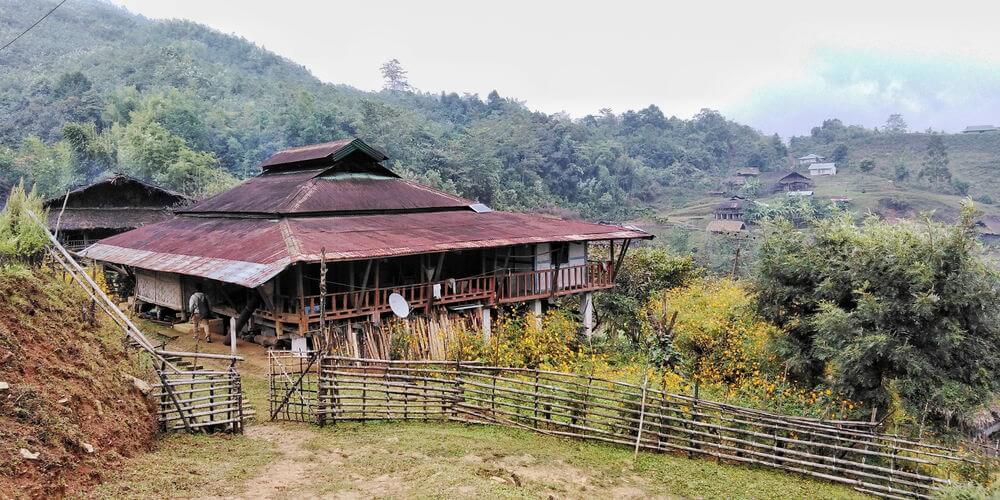
We reached safe and sound at Sago, a village deep inside Basar, Arunachal Pradesh. We were escorted inside a beautiful house made of wood. Men and women have separate entrances in a typical Galo house. Once inside, we saw the village headman, weaving a cap out of bamboo strips, sitting with other villagers around a fire – men on one side and women on the other. We sat around the warm fire while the villagers welcomed us with a little speech about themselves and how their village is completely plastic -free, sang a folk song and served glasses of Poka (traditional rice beer). When it was time to sleep, the villagers laid down mattresses, pillows, and blankets in the hall around the fire for us to sleep.
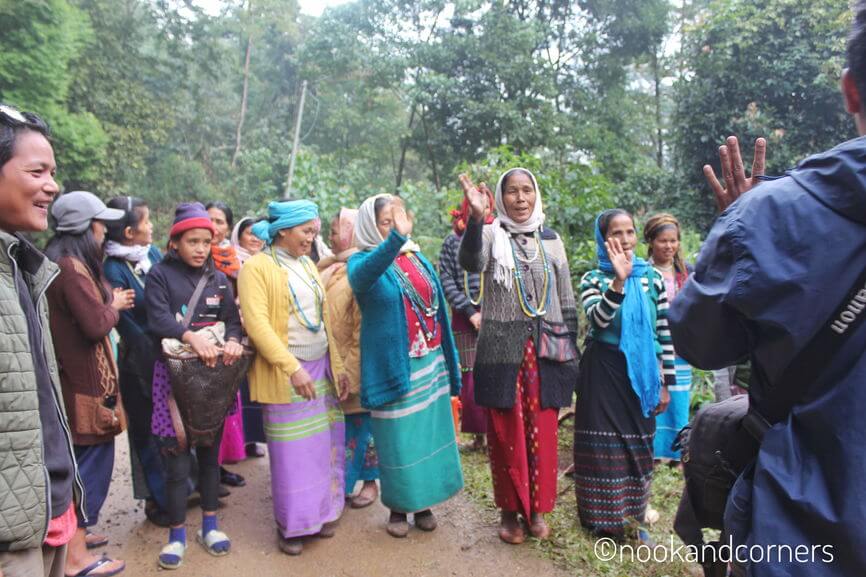
We woke up to see a beautiful village, with traditional wooden houses in the hills. Our hosts served us delicious plates of Maggi, thinking that their traditional food will not suit our appetite. They were accompanied by fresh guavas, plucked from the tree. And then they said they have a ‘surprise’ lunch planned for us. We were taken in cars to a certain place on the way and we saw the villagers cooking up a feast for us in middle of a forest. Freshly brewed Poka, smoked meat in leafy vegetables, and some vegetarian options in the traditional food awaited us.
We laughed, learnt their language, ate, drank, saw traditional fishing, and bade them goodbye before it got dark. We joined them in a folk dance, circling around the fire, before the goodbyes.
PIN THE POST
Thank you so much for sharing your best experience or memorable moment from North East India. It gives me immense joy that this side of the country has left such a beautiful impression.
Reach stories from North-East India – Assam, Nagaland, Manipur, Arunachal, Meghalaya
